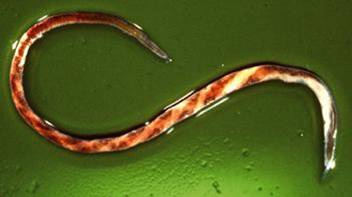When the goats arrived at the test site on May 31, a pooled fecal sample was collected from goats from each consignment. The eggs in the pooled sample were hatched for larvae identification, as you cannot differentiate (most) strongyle-type worms at the egg stage.
For the pooled sample collected on May 31, Haemonchus contortus (barber pole worm) comprised 82 percent of the worm infection. Twelve percent was Trichostrongylus spp. and 6 percent was other species.
Another pooled fecal sample was collected on June 27 from random goats. It takes several weeks to conduct the larvae identification. Dr. Dahlia O'Brien's parasitology lab at Delaware State University is doing all the fecal analyses for the 2013 buck test.
For the pooled sample collected on May 31, Haemonchus contortus (barber pole worm) comprised 82 percent of the worm infection. Twelve percent was Trichostrongylus spp. and 6 percent was other species.
 |
| The barber pole worm |
Another pooled fecal sample was collected on June 27 from random goats. It takes several weeks to conduct the larvae identification. Dr. Dahlia O'Brien's parasitology lab at Delaware State University is doing all the fecal analyses for the 2013 buck test.











